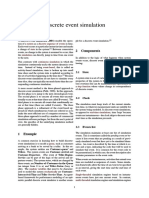Simpy: Simulation in Python: Roberto Solar Gallardo
Uploaded by
Roberto SolarSimpy: Simulation in Python: Roberto Solar Gallardo
Uploaded by
Roberto SolarIntroduction
Classes
Opeartions and functions
Examples
References
SimPy: Simulation in Python
Roberto Solar Gallardo
December 6, 2012
Introduction
Classes
Opeartions and functions
Examples
References
What is SimPy? object-oriented process-based discrete-event simulation language based on standard Python Features use of pythons generators
declare a function that behaves like an iterator a generator is resumable and can branch control elsewhere semi-coroutines
coroutines - functions that alternate execution with each other the exit/re-entry points are marked by pythons yield keywords
Introduction
Classes
Opeartions and functions
Examples
References
Simpy programming
The scheduler a list of future events is maintained automatically the scheduler is started by the SimPy command simulate Elements of discrete-event models Active elements: entities (Process) Passive elements: resources (Resource, Level and Store) General Structure of a SimPy program dene one or more SimPy classes and objects call the function initialize create and activate at least one of the active entities start the simulation by calling simulate report results
Introduction
Classes
Opeartions and functions
Examples
References
How it works
Simulation. t - Simpys clock Simulation. timestamps (heap) - event list (t,priority,instance)
1 2 3 4 5 6 7 8 9 10
class Cliente(Process): def visitar(self,tiempoDeServicio): print now(),self.name, ": He llegado" yield hold,self,tiempoDeServicio print now(),self.name, ": Ya me voy" initialize() c=Cliente(name="Roberto") activate(c,c.visitar(tiempoDeServicio=1.0),at=1.0) simulate(until=10.0)
Analysis
line 7: t=0 and timestamps=[] line 9: put c into timestamps (1.0,indened,c) line 4: put self into timestamps (now()+timehold,indened,self)
Introduction
Classes
Opeartions and functions
Examples
References
Processes
Features model an entity with activities i.e. instances of some class that inherits from SimPys Process class each entity has a standard method - Process execution method Process execution method (PEM) species entities actions in detail each PEM runs in parallel with (and may interact with) the PEMs of other entities
Introduction
Classes
Opeartions and functions
Examples
References
Resource facilities
simulates something to be queued for Resources model a service point with one or more identical service units Levels model a container of homogenous material which can be discrete (boxes, bricks, etc) or continuous (uid) Stores model a list of individual objects
Introduction
Classes
Opeartions and functions
Examples
References
Monitors
collects simulation data for analysis, statistics, etc Monitors used to compile summary statistics such as waiting times and queue lengths simple averages and variances time-weighted averages histograms Tallys is an alternative to Monitor that does essentially the same job but uses less storage space at some cost of speed and exibility
Introduction
Classes
Opeartions and functions
Examples
References
Operations and functions (1)
Process interaction statements activate(pi , pi .pem()[, at = t |delay = period ]) - make a process instance (pi ) active reactivate(pi [, at = now ()|delay = 0][, prior = false ]) - make a process intance (pi ) active (previously-passivated) cancel(pi ) - cancels all the events associated with a process intance (pi ) interrupt(pi ) - interrupt pi s current activity Simulation control statements initialize() - set simulated time to zero simulate(until=T ) - execute scheduled activities till T stopSimulation() - force immediate end of simulation
Introduction
Classes
Opeartions and functions
Examples
References
Operations and functions (2)
Scheduling statements yield hold,self,T - reactivate self after T yield passivate,self - make self passive yield request,self,resource - request use of resource yield release,self,resource - give up use of resource yield put,self,level,N - level is increased N units yield get,self,level,N - level is decreased N units
Introduction
Classes
Opeartions and functions
Examples
References
Cliente simple
from SimPy.Simulation import * class Cliente(Process): def visitar(self,tiempoDeServicio): print now(),self.name, ": He llegado" yield hold,self,tiempoDeServicio print now(),self.name, ": Ya me voy"
Output
1.0 Roberto : He llegado 2.0 Roberto : Ya me voy
initialize() c=Cliente(name="Roberto") activate(c,c.visitar(tiempoDeServicio=1.0),at=1.0) simulate(until=10.0)
Introduction
Classes
Opeartions and functions
Examples
References
Cliente simple, llegada aleatoria
from SimPy.Simulation import * from random import gammavariate, seed
Output
7.92130825474 Roberto : He llegado class Cliente(Process): 8.92130825474 Roberto : Ya me voy def visitar(self,tiempoDeServicio): print now(),self.name,": He llegado" yield hold,self,tiempoDeServicio print now(),self.name,": Ya me voy" seed() initialize() c=Cliente(name="Roberto"); inicio=gammavariate(4,1); activate(c,c.visitar(tiempoDeServicio=1.0),at=inicio) simulate(until=10.0);
Introduction
Classes
Opeartions and functions
Examples
References
Varios clientes
from SimPy.Simulation import * class Cliente(Process): def visitar(self,tiempoDeServicio): print now(),self.name, ": He llegado" yield hold,self,tiempoDeServicio print now(),self.name, ": Ya me voy"
Output
1.0 3.0 4.0 5.0 5.4 6.5 Roberto : He llegado Alonso : He llegado Roberto : Ya me voy Veronica : He llegado Alonso : Ya me voy Veronica : Ya me voy
initialize() c1=Cliente(name="Roberto") c2=Cliente(name="Alonso") c3=Cliente(name="Veronica") activate(c1,c1.visitar(tiempoDeServicio=3.0),at=1.0) activate(c2,c2.visitar(tiempoDeServicio=2.4),at=3.0) activate(c3,c3.visitar(tiempoDeServicio=1.5),at=5.0) simulate(until=100.0)
Introduction
Classes
Opeartions and functions
Examples
References
Muchos clientes
from SimPy.Simulation import * class Generador(Process): def generar(self,totalDeClientes,tasaDeLlegada): for i in range(totalDeClientes): c=Cliente(name="Cli-%02d"%(i)) activate(c,c.visitar(tiempoDeServicio=3.5)) yield hold,self,tasaDeLlegada
Output
Cli-00: Cli-01: Cli-00: Cli-02: Cli-01: Cli-03: Cli-02: Cli-04: Cli-03: Cli-04: He He Ya He Ya He Ya He Ya Ya llegado llegado me voy llegado me voy llegado me voy llegado me voy me voy
0.0 2.5 3.5 5.0 6.0 7.5 8.5 class Cliente(Process): 10.0 def visitar(self,tiempoDeServicio): 11.0 print "%2.1f %s: He llegado"%(now(),self.name) 13.5 yield hold,self,tiempoDeServicio print "%2.1f %s: Ya me voy"%(now(),self.name)
initialize() g=Generador(); activate(g,g.generar(totalDeClientes=5,tasaDeLlegada=2.5)) simulate(until=100.0)
Introduction
Classes
Opeartions and functions
Examples
References
Muchos clientes, un recurso
from SimPy.Simulation import * from random import expovariate,seed class Generador(Process): def generar(self,totalDeClientes,tasaDeLlegada,recurso): for i in range(totalDeClientes): c=Cliente(name="Cli-%02d"%(i)) activate(c,c.visitar(tiempoDeServicio=2.7,recurso=recurso)) t=expovariate(1.0/tasaDeLlegada); yield hold,self,t
Output
0.0 0.0 2.3 2.7 2.7 3.1 5.4 5.4 8.1 Cli-00: Cli-00: Cli-01: Cli-00: Cli-01: Cli-02: Cli-01: Cli-02: Cli-02: He T. He Ya T. He Ya T. Ya llegado Espera 0.0 llegado me voy Espera 0.4 llegado me voy Espera 2.3 me voy
class Cliente(Process): def visitar(self,tiempoDeServicio=0,recurso=None): llegada=now() print "%2.1f %s: He llegado"%(now(),self.name) yield request,self,recurso tiempoDeEspera=now()-llegada; print "%2.1f %s: Tiempo de espera %2.1f"%(now(),self.name,tiempoDeEspera) yield hold,self,tiempoDeServicio yield release,self,recurso print "%2.1f %s: Ya me voy"%(now(),self.name)
recurso=Resource(name="Contador",unitName="Cajero"); seed() initialize() g=Generador(); activate(g,g.generar(totalDeClientes=3,tasaDeLlegada=3.0,recurso=recurso),at=0.0) simulate(until=100.0)
Introduction
Classes
Opeartions and functions
Examples
References
El banco
from SimPy.Simulation import * from random import expovariate, seed MEDIA_TIEMPO_DE_SERVICIO=5.0 MEDIA_TIEMPO_DE_LLEGADA=2.5 class Generador(Process): def generar(self,totalDeClientes,recurso): for i in range(totalDeClientes): c=Cliente(name="Cliente-"+str(i)); activate(c,c.visitar(recurso=recurso)); tiempoDeLlegada=expovariate(1.0/MEDIA_TIEMPO_DE_LLEGADA); yield hold,self,tiempoDeLlegada class Cliente(Process): def visitar(self,recurso): llegada=now() yield request,self,recurso tiempoDeEspera=now()-llegada monitor.observe(tiempoDeEspera); tiempoDeServicio=expovariate(1.0/MEDIA_TIEMPO_DE_SERVICIO) yield hold,self,tiempoDeServicio yield release,self,recurso seed() initialize() monitor=Monitor(); banco=Resource(name="Banco",unitName="Cajero",capacity=2) generador=Generador(name="Generador") activate(generador,generador.generar(totalDeClientes=1000,recurso=banco)) simulate(until=2000) resultado=monitor.count(),monitor.mean() print "El tiempo promedio de espera de %d atenciones fue %f"%resultado
Introduction
Classes
Opeartions and functions
Examples
References
SimPlot
Introduction
Classes
Opeartions and functions
Examples
References
1 2
http://sourceforge.net/projects/simpy/ http://simpy.sourceforge.net/SimPyDocs/_static/ TheBank.pdf http://msor.victoria.ac.nz/twiki/pub/Courses/ OPRE354_2012T2/MoreReferences/LecturesOnSimPy.pdf http://python-ray.googlecode.com/hg-history/ 66da0654aaced5c4d2a8d26f2a17707d63c97174/doc/ PyIterGen.pdf
Introduction
Classes
Opeartions and functions
Examples
References
THE END
You might also like
- VMAX3 Installation and Maintenance STUDENT LabGuideNo ratings yetVMAX3 Installation and Maintenance STUDENT LabGuide34 pages
- SimPy For First Time Users - SimPy v2.2 DocumentationNo ratings yetSimPy For First Time Users - SimPy v2.2 Documentation15 pages
- SimPy Manual - SimPy 2.3b1 Documentation PDFNo ratings yetSimPy Manual - SimPy 2.3b1 Documentation PDF54 pages
- How To Build Valid and Credible Simulation Models100% (1)How To Build Valid and Credible Simulation Models8 pages
- Spring 2022 CS7643 Deep Learning Syllabus and Schedule - v5.1No ratings yetSpring 2022 CS7643 Deep Learning Syllabus and Schedule - v5.111 pages
- General Idea of Iterative Models-Spiral ModelNo ratings yetGeneral Idea of Iterative Models-Spiral Model30 pages
- Falk M. A First Course On Time Series Analysis Examples With SAS (U. of Wurzburg, 2005) (214s) - GL100% (1)Falk M. A First Course On Time Series Analysis Examples With SAS (U. of Wurzburg, 2005) (214s) - GL214 pages
- Streamlit PDF Application Setup All Commands in One Single FileNo ratings yetStreamlit PDF Application Setup All Commands in One Single File8 pages
- Operation Research Problems Solving in Python: Prepared by Saurav BaruaNo ratings yetOperation Research Problems Solving in Python: Prepared by Saurav Barua15 pages
- Simulation and Queueing Theory: Topic 8No ratings yetSimulation and Queueing Theory: Topic 823 pages
- General Principles & Concepts in Discrete Event Simulation PPT - GJS100% (1)General Principles & Concepts in Discrete Event Simulation PPT - GJS46 pages
- Machine Learning: Andrew NG's Course From Coursera: Presentation100% (1)Machine Learning: Andrew NG's Course From Coursera: Presentation4 pages
- Data Science A Beginner S Guide 1668243666100% (1)Data Science A Beginner S Guide 166824366626 pages
- Plete Python Manual 4th HQ PDF-Edition 2019No ratings yetPlete Python Manual 4th HQ PDF-Edition 2019163 pages
- Complex Network Analysis in Python Recognize Construct Visualize Analyze Interpret 1st Edition Dmitry Zinoviev All Chapters Instant Download100% (6)Complex Network Analysis in Python Recognize Construct Visualize Analyze Interpret 1st Edition Dmitry Zinoviev All Chapters Instant Download50 pages
- Fuzzy Logic: UIET (Computer Science Deptt)100% (1)Fuzzy Logic: UIET (Computer Science Deptt)56 pages
- How A Kalman Filter Works, in Pictures - Bzarg100% (1)How A Kalman Filter Works, in Pictures - Bzarg81 pages
- Medians and Order Statistics: CLRS Chapter 9No ratings yetMedians and Order Statistics: CLRS Chapter 919 pages
- Introduction To Data Visualization With PythonNo ratings yetIntroduction To Data Visualization With Python47 pages
- Fronczak, Reniers - Model-Based Systems Engineering - 4TC00 Dictaat 2014-2015 PDFNo ratings yetFronczak, Reniers - Model-Based Systems Engineering - 4TC00 Dictaat 2014-2015 PDF105 pages
- Vision-Face Recognition Attendance Monitoring System For Surveillance Using Deep Learning Technology and Computer VisionNo ratings yetVision-Face Recognition Attendance Monitoring System For Surveillance Using Deep Learning Technology and Computer Vision5 pages
- Flexible Flow Shop Sheduling Problem With Machine Eligibility100% (1)Flexible Flow Shop Sheduling Problem With Machine Eligibility12 pages
- Probabilistic Reasoning in Artificial IntelligenceNo ratings yetProbabilistic Reasoning in Artificial Intelligence7 pages
- Simpy Documentation: Release 4.0.2.Dev1+G2973DbeNo ratings yetSimpy Documentation: Release 4.0.2.Dev1+G2973Dbe107 pages
- Simpy: System Simulation in Python: Dr. Klaus G. MüllerNo ratings yetSimpy: System Simulation in Python: Dr. Klaus G. Müller22 pages
- There Is No Such Thing As A Microservice!: Chris RichardsonNo ratings yetThere Is No Such Thing As A Microservice!: Chris Richardson71 pages
- SOFTWARE LICENSE: General Terms and ConditionsNo ratings yetSOFTWARE LICENSE: General Terms and Conditions2 pages
- Enterprise Nas HDD: SATA Product ManualNo ratings yetEnterprise Nas HDD: SATA Product Manual29 pages
- Vinayak Soin 102115159 3NC7: Name of Student: Roll Number: GroupNo ratings yetVinayak Soin 102115159 3NC7: Name of Student: Roll Number: Group3 pages
- Course Outline Web Design and DevelopmentNo ratings yetCourse Outline Web Design and Development2 pages
- Nubee'S Newbie Guide For Fcom: Last Revised July 16, 2016No ratings yetNubee'S Newbie Guide For Fcom: Last Revised July 16, 201610 pages
- Rail Training Conference - Rail Training Through Driving Simulators. Integration of The Human FactorNo ratings yetRail Training Conference - Rail Training Through Driving Simulators. Integration of The Human Factor8 pages
- Asset Management of Oil and Gas Pipeline System Based On Digital TwinNo ratings yetAsset Management of Oil and Gas Pipeline System Based On Digital Twin5 pages
- (Certification Guide) Omar Santos, Joseph Muniz, Stefano de Crescenzo - CCNA Cyber Ops SECFND #210-250 Official Cert Guide-Cisco Press (2017)No ratings yet(Certification Guide) Omar Santos, Joseph Muniz, Stefano de Crescenzo - CCNA Cyber Ops SECFND #210-250 Official Cert Guide-Cisco Press (2017)7 pages
- Alvin C. Samonte Yahoo Inc Case Study AnalysisNo ratings yetAlvin C. Samonte Yahoo Inc Case Study Analysis19 pages
- VMAX3 Installation and Maintenance STUDENT LabGuideVMAX3 Installation and Maintenance STUDENT LabGuide
- SimPy For First Time Users - SimPy v2.2 DocumentationSimPy For First Time Users - SimPy v2.2 Documentation
- Spring 2022 CS7643 Deep Learning Syllabus and Schedule - v5.1Spring 2022 CS7643 Deep Learning Syllabus and Schedule - v5.1
- Falk M. A First Course On Time Series Analysis Examples With SAS (U. of Wurzburg, 2005) (214s) - GLFalk M. A First Course On Time Series Analysis Examples With SAS (U. of Wurzburg, 2005) (214s) - GL
- Streamlit PDF Application Setup All Commands in One Single FileStreamlit PDF Application Setup All Commands in One Single File
- Operation Research Problems Solving in Python: Prepared by Saurav BaruaOperation Research Problems Solving in Python: Prepared by Saurav Barua
- General Principles & Concepts in Discrete Event Simulation PPT - GJSGeneral Principles & Concepts in Discrete Event Simulation PPT - GJS
- Machine Learning: Andrew NG's Course From Coursera: PresentationMachine Learning: Andrew NG's Course From Coursera: Presentation
- Complex Network Analysis in Python Recognize Construct Visualize Analyze Interpret 1st Edition Dmitry Zinoviev All Chapters Instant DownloadComplex Network Analysis in Python Recognize Construct Visualize Analyze Interpret 1st Edition Dmitry Zinoviev All Chapters Instant Download
- Fronczak, Reniers - Model-Based Systems Engineering - 4TC00 Dictaat 2014-2015 PDFFronczak, Reniers - Model-Based Systems Engineering - 4TC00 Dictaat 2014-2015 PDF
- Vision-Face Recognition Attendance Monitoring System For Surveillance Using Deep Learning Technology and Computer VisionVision-Face Recognition Attendance Monitoring System For Surveillance Using Deep Learning Technology and Computer Vision
- Flexible Flow Shop Sheduling Problem With Machine EligibilityFlexible Flow Shop Sheduling Problem With Machine Eligibility
- Probabilistic Reasoning in Artificial IntelligenceProbabilistic Reasoning in Artificial Intelligence
- Simpy: System Simulation in Python: Dr. Klaus G. MüllerSimpy: System Simulation in Python: Dr. Klaus G. Müller
- There Is No Such Thing As A Microservice!: Chris RichardsonThere Is No Such Thing As A Microservice!: Chris Richardson
- Vinayak Soin 102115159 3NC7: Name of Student: Roll Number: GroupVinayak Soin 102115159 3NC7: Name of Student: Roll Number: Group
- Nubee'S Newbie Guide For Fcom: Last Revised July 16, 2016Nubee'S Newbie Guide For Fcom: Last Revised July 16, 2016
- Rail Training Conference - Rail Training Through Driving Simulators. Integration of The Human FactorRail Training Conference - Rail Training Through Driving Simulators. Integration of The Human Factor
- Asset Management of Oil and Gas Pipeline System Based On Digital TwinAsset Management of Oil and Gas Pipeline System Based On Digital Twin
- (Certification Guide) Omar Santos, Joseph Muniz, Stefano de Crescenzo - CCNA Cyber Ops SECFND #210-250 Official Cert Guide-Cisco Press (2017)(Certification Guide) Omar Santos, Joseph Muniz, Stefano de Crescenzo - CCNA Cyber Ops SECFND #210-250 Official Cert Guide-Cisco Press (2017)

























































































